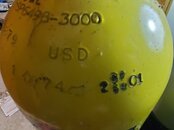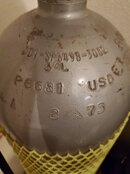You are using an out of date browser. It may not display this or other websites correctly.
You should upgrade or use an alternative browser.
You should upgrade or use an alternative browser.
AL tanks and diving wet
- Thread starter Cthippo
- Start date
Please register or login
Welcome to ScubaBoard, the world's largest scuba diving community. Registration is not required to read the forums, but we encourage you to join. Joining has its benefits and enables you to participate in the discussions.
Benefits of registering include
- Ability to post and comment on topics and discussions.
- A Free photo gallery to share your dive photos with the world.
- You can make this box go away
I think I (and perhaps others) misread your intentions in your opening post. I gathered from what you wrote there that you understood that diving with an aluminum tank with a wetsuit was a serious mistake. The phrase "especially in cold water" implies it is a mistake in any water.I'm not going to name names because, as you say, I may have misinterpreted what was being said, but some quotes from threads I read or posted in at one point or another..
"It’s silly to dive AL80s in cold water due to all the lead you need."
"The defacto std steel cylinder is the HP100. Given you dive cold water I would recommend that as it will have better buoyancy characteristics over an Al80. By better meaning more negative thus requiring less weight on a belt (or wherever you put it)."
"For cold fresh water, steels are probably the way to go."
"aluminum is worse weight to capacity hence why steel is preferred. aluminum is popular for rental fleets because they are cheaper to buy in bulk and they tolerate corrosion/abuse better in tropical environments. the buoyancy difference does make aluminum 40/80 useful for deco/stage usage."
"Steel tanks provide more negative buoyancy than Aluminum. For example, you will need to add 5 lbs of lead to your weight belt to achieve the same buoyancy with an Al80 as you would get with a steel HP100.
"Steel also lasts at least twice as long as AL given even minimal care (i.e., rinse after saltwater dives, store somewhere dry, and keep at least a couple hundred psi in the tank so water can't get in)."
"The only real advantage of AL for single tank backmount is initial cost."
"In my experience, aluminium tanks are usually more common in warm places, where you dive in very thin suits and, therefore, you need less weight."
"AL80s are very nice in warm water with minimal exposure protection. In those instances steels can be a bit too negative. They also have better corrosion resistance to salt. If I always wore a thick wetsuit or a drysuit, the AL80s would never get used."
"I consider AL80s a very poor choice for cold water divers, especially people who own their tanks. I refuse to dive aluminums now unless they’re a deco or stage bottle."
"Not all diving is single tank diving. For a single tank in cold water, an AL80 is a horrible choice."
Your quotes here are pretty much all people expressing a preference, sometimes a strong preference, for steel tanks, especially in cold water. As I wrote before, I have such a preference myself.
That does not, however, mean it is wrong to dive with an aluminum tank and a wetsuit, especially in warm water. You just have to understand your weighting needs.
Eric Sedletzky
Contributor
Another reason some people in thick wetsuits don’t like aluminum tanks, is that when the tank empties they get really butt light and the tank can stick up. The neck and the top end stay slightly negative because the thickness of the neck area combined with the first stage. If the diver is using a larger weightbelt then they’re being pulled down at the waist as the base of the tank is wanting to go up and it can get awkward.
But, if all there was to use was aluminum tanks or not dive at all I’d use the aluminum 80 and just deal with it. It’s not ideal but not the end of the world either.
Then there was the negative aluminum tanks, remember those? Monsters out of the water. I never understood the point, just get a steel.
Also aluminums have a life span of something like 20,000 cycles? Aluminum tank alloy does wear out. I’m not sure of the exact cycle amount. Properly cared for steels do not have a life span, technically they can go on forever.
But, if all there was to use was aluminum tanks or not dive at all I’d use the aluminum 80 and just deal with it. It’s not ideal but not the end of the world either.
Then there was the negative aluminum tanks, remember those? Monsters out of the water. I never understood the point, just get a steel.
Also aluminums have a life span of something like 20,000 cycles? Aluminum tank alloy does wear out. I’m not sure of the exact cycle amount. Properly cared for steels do not have a life span, technically they can go on forever.
I recently discovered that nobody really knows how long aluminum tanks last.Also aluminums have a life span of something like 20,000 cycles? Aluminum tank alloy does wear out. I’m not sure of the exact cycle amount.
In a thread related to a shop refusing to fill aluminum tanks over 20 years old, people were speculating that it related to the bad alloy from back in the day, and that is what I thought, too. I did a Google search and found a variety of articles of different ages on this topic, several of them from Undercurrent magazine. The older articles tended to be issuing dire warnings about aging aluminum tanks. One said they should be replaced after 10 years! Others said 15 years. As the articles got newer and newer, the time limits got longer and longer. That includes articles in Undercurrent from different eras, both citing the same authority--a dive shop with no expertise beyond what you find on ScubaBoard.
I found nothing with any clearly recognizable scientific evidence.
The two dive shops in my town use nothing but aluminum, and I would bet that many tanks in their inventories are over 30 years old.
Boarderguy
Chief Narctopus Wrangler
My 2 AL 80s are from 73 and 74. They still pass VIP, Eddy, and Hydro every cycle. Local owned shops are less likely to have generic bias against perfectly good tanks.I recently discovered that nobody really knows how long aluminum tanks last.
In a thread related to a shop refusing to fill aluminum tanks over 20 years old, people were speculating that it related to the bad alloy from back in the day, and that is what I thought, too. I did a Google search and found a variety of articles of different ages on this topic, several of them from Undercurrent magazine. The older articles tended to be issuing dire warnings about aging aluminum tanks. One said they should be replaced after 10 years! Others said 15 years. As the articles got newer and newer, the time limits got longer and longer. That includes articles in Undercurrent from different eras, both sitting the same authority--a dive shop with no expertise beyond what you find on ScubaBoard.
I found nothing with any clearly recognizable scientific evidence.
The two dive shops in my town use nothing but aluminum, and I would bet that many tanks in their inventories are over 30 years old.
Attachments
I’ve just discovered that many divers are now being taught only the frog kick and inefficient elevated flutter Kick by GUE and other instructors. Because of this, it is entirely possible that a new diver could not ”kick up” a 10 pound load because they don’t have the kicking skills to do that. It seems to me to be an instructional problem that divers are not now being taught powerful kicks.I dive wet with both steel and AL and adjust my lead based on which tank I grab. I'm still trying to figure out how a diver could not swim up their full kit when wet... total bc failure = ditch some weight and start kicking up. The majority of us could tread water in just swim trunks (with effort) with 10-15 lbs, why couldn't that same majority kick up 20-25 lb with fins on? 35-40 would suck but is doable especially as your wetsuit regains buoyancy. Drop one pocket and start working your way up to avoid an uncontrolled ascent. Drop the other once on the surface of you still are not floaty. Factoring in a tank's buoyancy is nice but unnecessary. If rather have the extra air and better trim from my steels than the floaty AL 80s.
SeaRat
Oh shoot. If this is true, then I'm in trouble. I've been diving in a 7mm wetsuit with aluminum tanks for years... many years. Somehow I survived! (I dove just last week in this config, and I'm diving the same tomorrow.)I've been told, mostly on this board, that aluminum tanks are not really suitable for diving with a wetsuit, especially in colder water. My understanding is that this is because of the net positive buoyancy of an empty AL tank needing more lead to counteract. That makes sense up to a point, but is it really enough to not dive the most common tank on the market because I use a wetsuit? It seems like both a steel and AL tank will lose the same amount of weight as the air is released and from the tank data I have seen the difference is less than 5 lbs.
Whoever told you this was probably just very confused on how buoyancy works. It happens. Physics is tough.
And yes, what you said: a steel tank and an aluminum tank lose the same amount of air, and therefore the same weight, as the air is used.
Similar threads
- Replies
- 31
- Views
- 4,798
- Replies
- 32
- Views
- 3,911
- Replies
- 3
- Views
- 385





